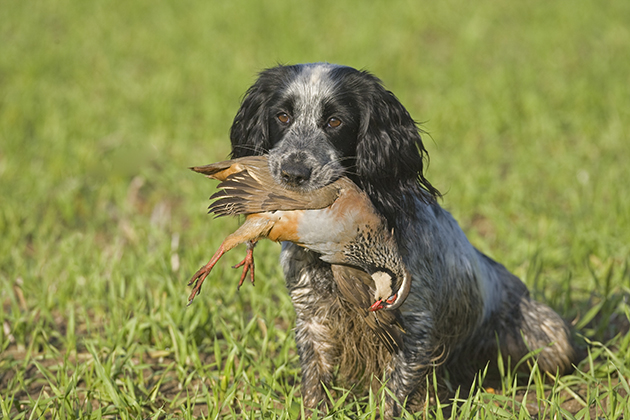Scotland ends tail docking ban
The blanket ban on tail docking in Scotland has been overturned after a decade, with vets allowed to shorten tails by a third for working spaniels and HPR breeds.

Mandatory Credit: Photo by FLPA/REX/Shutterstock (3268975a) Domestic Dog, English Cocker Spaniel, adult, holding shot Red-legged Partridge (Alectoris rufa) in mouth, Norfolk, England Nature
The Scottish Government this week voted in favour of allowing vets to shorten the tails of spaniels and hunt, point, retrievers (HPR) if they will be used as working dogs.
Legislation was laid in May, with environment secretary Roseanna Cunningham pledging to introduce a bill to drop the existing ban as part of a series of animal welfare improvements.
The vote was finally passed in Holyrood on Wednesday, with 86 MSPs in support of an amendment, while 29 were opposed and nine abstained.
Once the legislation is implemented, vets will be able to shorten the tails of spaniels and HPRs by up to one-third if they have good reason to believe the dog will go into active work.
A decade of painful injuries
Scottish Gamekeepers Association chairman Alex Hogg said the result was “recompense for all working spaniels and HPRs that have had to endure 10 years of painful injuries”.
He added: “The ban on tail docking in 2007 was made with good intentions but failed to account for working dogs, whose jobs are very specific. The welfare of these animals was compromised by the legislation and the Scottish Government deserves immense credit for taking a progressive, evidence-based step to rectify that today.”
The result has been met with disappointment by a number of animal welfare charities. Runa Hanaghan, deputy veterinary director at the Dogs Trust, said the charity was “deeply saddened by the decision” and commented that “tail docking involves severing bone, nerve, muscle and connective tissue when puppies are less than five days old, at which point it is very difficult to guarantee they will go on to be working dogs”.
Tail shortening is not full docking
Mr Hogg addressed such comments, stating: “Some have conflated tail shortening with full tail docking, which leaves dogs with only a stump. This is the opposite. It is a quick, preventative procedure protecting the animal over its whole working life, leaving it with an expressive, waggy tail.”
He added: “Failure to act, when Glasgow University research showed that more than half of spaniels, without shortened tails, were injured in a single season, would have been to turn a blind eye to suffering.
“The Scottish Government, vets who have experienced the welfare issues first-hand, and all other MSPs who have supported working dogs, can be assured that they have done the right thing.”
Alan Marshall, a vet and a member of BASC’s Scottish committee, agreed: “A great many country sportsmen and women with working dogs will welcome the long-awaited decision to reintroduce tail shortening for the working spaniel and HPR breeds.
“During the 10 years it has taken to reverse this legislation the welfare of these dogs has suffered. We applaud the Scottish Parliament for this long-awaited but sensible and proportionate welfare decision.”
Scotland drops its ban on tail docking
Holyrood has announced plans to change tail docking legislation to allow the tails of spaniel and hunt, point, retrieve (HPR) puppies to be…
Important recognition for rural workers
Nicolle Hamilton from BASC Scotland described the result as “an important step for animal welfare”. She added: “[It is an] important recognition from the Scottish Parliament that people working in rural environments have the best interests of their dogs at heart. Scottish spaniel and HPR breeding lines will be reinstated — once the law has changed, people will no longer have to go over the border to source working dogs with shortened tails.”









